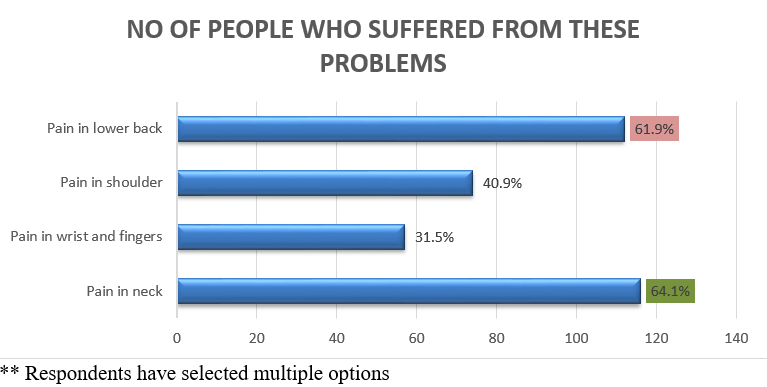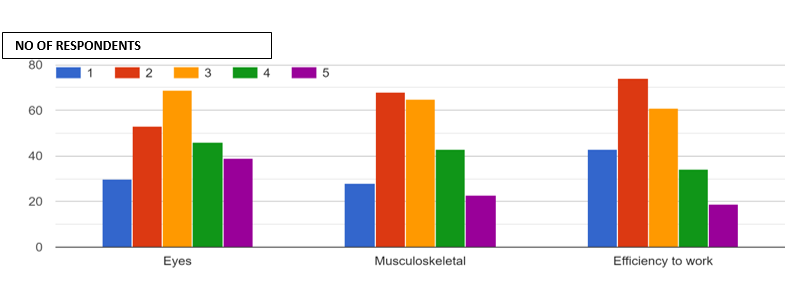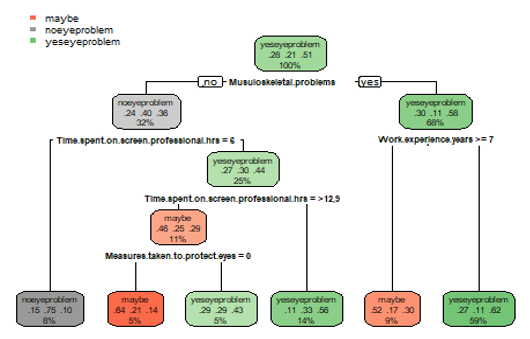Introduction
Computers have grown indispensable and pervasive in all aspects of life. Because of their increasing utility, human reliance on them is growing. Electronic gadgets such as computers, laptops, mobile phones, tablets, and other screen-based devices are excellent and much needed for communication, virtual exchanges and human interactions. (Pandya & Lodha, 2021)
Computers are crucial in the life of an IT professional. The average amount of time spent on the screen each day on any device is increasing day by day worldwide. As Sundar Pichai said during the keynote of Google Cloud Next '20, "The future of work will be more digital. We are already seeing the long-term acceleration of businesses moving to digital services, including increased online work, education, medicine, shopping and entertainment. These changes will be significant and lasting." (Goodson, 2022)1, 2, 3, 4, 5
Integrating technology into the workplace boosts efficiency, which is critical for staying competitive. But too much Use can cause problems with the muscles and joints, eyestrain, and overuse injuries in the hands and wrists. It can also cause stress, poor job performance, and other problems.
Concerns about the impact of excessive screen usage on physical and mental health have arisen. While using technology in a responsible and controlled manner is essential, excessive screen usage is associated with ill health. It's been linked to many detrimental mental and physical health issues. Psychological issues, low self-esteem, and other adverse health effects include a lack of emotional stability and a higher likelihood of depression or distress. (Allen et al., 2019).
Visual and musculoskeletal symptoms are common among IT professionals, which affect their efficiency and willingness to work. Individual, work-related, and non-work-related physical and psychosocial factors may all contribute to the development and impairment of these symptoms. (Bongers et al., 2006).
This study was done to determine employees' problems and the measures they take to deal with them. Also, what steps can employers and employees bring to deal with the problems collaboratively?6, 7, 8, 9
Literature Review
Computers and mobile devices have revolutionized the workplace and society, delivering plenty of business tools and more convenient access to information. The computer revolution has impacted every element of life, including IT, business, leisure, health, education, and so on. But it comes with specific adverse effects. In studies, increased screen usage has been shown to harm physical and mental health. In earlier research, screen time is linked with a wide range of non-communicable diseases among vulnerable individuals. (Sultana et al., 2021; Janssen et al., 2020) Obsessive, excessive, compulsive, impulsive, and hurried usage of digital gadgets is all signs of problematic screen time (Lodha, 2018). The health impacts on workers who spend more than 6-8 hours in front of computers are potential flashpoints. (Singh & Wadhwa, 2006).
Excessive screen time causes three fundamental problems: communication breakdowns, distractions, and disconnection. Computer-induced health problems are a broad phrase that encompasses a wide range of issues that a computer user may have due to excessive or inappropriate computer use. (Sharma, 2016)Vision problems, musculoskeletal problems, sleep problems, decreased job performance, increased stress, unfavourable eating habits, shorter life expectancy, cardiovascular health problems and diabetes, cognitive problems, and so on are only a few of them.
Covid19 increased digital media usage, such as desktops, laptops, tablet computers, and mobile phones, as schools, businesses, and other institutions were shut down. This led to a significant impact on the sleep of the respondents.(Drumheller & Fan, 2022)
In his keynote of Google, Sundar pichi could next talk about the fact that the future will be digital." "More than 75 per cent of companies plan to accelerate their digital transformations. As large teams and organizations know, collaboration is key to success. Using tools like cloud productivity suites and video conferencing, we've all been able to transition to work from home successfully." (Goodison, 2022).
Physical health effects
Excessive screen time has physical health consequences such as eye strain, tired eyes, irritation, redness, blurred vision, double vision (often referred to as computer vision syndrome) and decreased bone density. (Lissak, 2018) Nearly half to ninety per cent of persons who glare at a computer screen have at least some signs of eye problems. Because digital screens are backlit and emit blue light, they irritate the retina and may cause long-term damage. It also suppresses the sleep hormone melatonin, causing an artificial sense of awakening and disturbing sleep cycles, which contributes to increased eye strain. When people stare at a screen for long periods, their blinking rate drops to nearly half, resulting in Dry Eyes ((Martin, Murphy, Molina-Soberanes & Murtagh, 2022; Seidman, 2015; WebMD, 2015).
Back and posture disorders are another medical issue brought on by prolonged computer use. Musculoskeletal problems mainly cause these issues. Neck, shoulder, and back pain are all included. The channel, shoulders, and back are strained by time spent typing or holding a phone while looking down. Continuous sitting postures may raise the risk of adverse health consequences, including low-back discomfort, and several factors can influence this risk. (Jia & Nussbaum, 2018) Sitting in certain positions for an extended period can cause pain and, in some cases, more severe musculoskeletal problems. Carpal tunnel syndrome is the name for these issues (CTS). It is an injury produced by repetitive movement of joints, particularly the wrist, which causes tension and can result in musculoskeletal problems. People who spend a lot of time in front of computers must remember when working on the computer. These apps block distracting websites on their phones and turn off notifications to avoid unnecessary screen contact.
A large portion of this issue (Ali and Sathiyasekaran, 2006). A link has been shown in several cross-sectional investigations between computer-related exposures and personal problems in the neck and upper limbs. The findings imply that steps to limit mouse use, improve the comfort of the computer work environment, and reduce job strain should be included in preventive initiatives to minimize neck and upper-limb symptoms among computer users. (Wiganers, Tornqvist et al., 2009).
Poor sleep is linked to other physical health problems, such as high blood pressure and obesity, risk factors for cardiovascular disease. (Cooper & Marshall, 1976).
Psychological effects
Sleep deprivation has been linked to internalizing and externalizing behaviour. Screen use causes insomnia, which leads to depressive symptoms and suicidal ideation. The Use of digital devices at night causes a loss of concentration, which affects job performance by causing a lack of focus and more distraction. (Lissak, 2018).
The 2005–2006 US National Health and Nutrition Examination Survey found that adults who used screens more frequently (more than 6 hours per day) had a higher likelihood of having issues with sleep onset latency. (Vallance et al., 2015). Additionally, three included studies discovered a connection between more screen time and a longer sleep onset delay. Increased screen time resulted in shorter sleep duration, lower sleep quality, and more complaints of sleep disruptions. (Cellini et al., 2020; Salfi et al., 2021).
Psychoneurological effects
Addictive screen time use reduces social coping and results in seeking behaviour that reflects a person's dependence on staring at a screen. Screen addiction develops due to constant staring at the screen, leading to feelings of isolation and social anxiety. This might sometimes make you feel irritated and stressed. (Lissak, 2018). Too much screen time in the workplace harms employees' health and well-being.
A steady mind, solid social coping and attachment and good physical health are all required for psychological and physiological resilience. Professionals' excessive Use of digital devices appears to be the main issue that may obstruct the development of sound psychological resilience.
Excessive computer usage is an unavoidable aspect of a professional's life. However, several steps may be taken to control, monitor, avoid, and lessen workplace screen addiction.
It entails holding device-free meetings, requiring employees to take a proper lunch break away from their desks, and adhering to the 20-20-20 rule. Every 20 minutes, look away for a full 20 seconds at an item around 20 feet away. Dry eyes are caused by not blinking enough, so try yoga, keep your computer at the proper distance, support your back, and don't sit with your knees bent. All of these things can help your posture. Mindfulness meditation, deep breathing, guided visualization, and progressive relaxation techniques can reduce stress. (Sharma, 2016b).
Suppose initiatives can be devised to aid employees in counteracting the possible harmful impacts of computers and screen time. In that case, it will be a commendable initiative for the organizations. Employees at the entry level can be urged to follow the 20-20-20 rule and take physical breaks. Employers might benefit from yoga programmes to lessen the musculoskeletal burden. Mindfulness meditation programmes can be used to counteract the adverse effects of excessive screen use on the brain and cognitive performance. In businesses, surveys are done to improve the programmes and see how they affect employers' lives. ("10 Tips For Decreasing The Negative Effects Of Too Much Screen Time", 2022)
Materials and Methods
The present study was conducted among IT professionals working all across India. A total of 259 computer professionals were selected for the study. Individuals were assigned from different states in India. Also, employees from ETech (an IT company in Gandhinagar) were surveyed. Permission to conduct the study was obtained from the office.
It was explained to the subjects what the study was about, and they were assured that the information obtained would be kept confidential and anonymous. Data was collected by developing a questionnaire using a Google form that included details such as age, sex, working hours, time spent on screen, and detailed information about the experiences of various visual or musculoskeletal problems and the measures taken by the people to resolve them. Thus, the data was converted into a computer-based spreadsheet and analyzed using descriptive studies, decision trees, and word charts.
Results
The present study included 259 computer professionals from all across India. With the following age group.
Table 1
Age group-wise distribution of the respondents
|
Age group |
Percentage |
|
Below 21 |
1.2 |
|
21-25 |
64.5 |
|
25-30 |
16.2 |
|
30-40 |
13.5 |
|
Above 40 |
4.6 |
It was found that the maximum population was between the ages of 21-25. Of the participants, 66.6% were male, and 32.4% were female.
Table 2
Time spent on screen-wise distribution of respondents
|
Time spent for professional use |
Percentage of Respondents |
|
6 hours or less |
15.1% |
|
6-8 hours |
30.5% |
|
8-10 hours |
35.5% |
|
10 - 12 hours |
12.7% |
|
More than 12 hours |
6.2% |
|
|
|
It was found that most respondents spent around 8-10 hours in front of the screen.
Table 3
Work experience-wise distribution of the respondents
|
Work Experience |
Percentage of Respondents |
|
Less than 1 year |
39.4% |
|
1-3 years |
29.3% |
|
4-8 years |
17% |
|
More than 8 years |
14.3% |
It was found that most respondents had a work experience between 1-3 years.
Visual problems
The prevalence of visual problems found in the study group was 79% of the respondents suffered from eye problems (responses of yes and maybe). The subjects were asked about the various visual issues they experienced.
Figure 1
Distribution of visual problems among the respondents**Respondents have selected multiple options
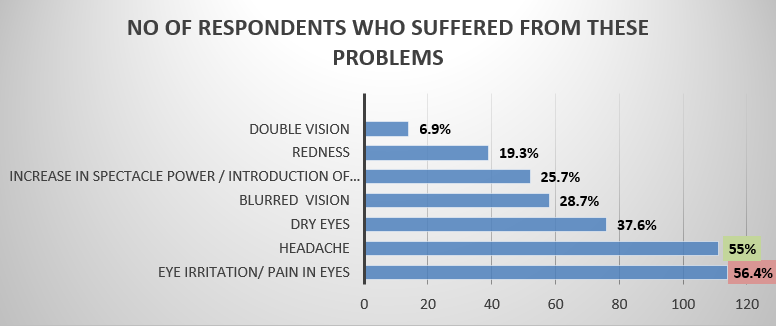
Along with these problems, people also mentioned that they suffered from problems like watering, cervical pain, dehydration, lack of concentration, style, migraine, itching, irritation when exposed to the sun, etc.
Table 4
Distribution of measures taken by the respondents to prevent the adverse effects of the screen on eyes
Out of the total respondents with a prevalence of visual problems, it was found that 38.53% of people took no measure to prevent the adverse effects of screens on their eyes. At the same time, others take the following (table 4) precautions to avoid the impact of screen time.
Musculoskeletal problems
When asked about the musculoskeletal problems faced by the people, the prevalence of musculoskeletal issues was reported at 67.56% suffered from musculoskeletal pain.
Table 5
Distribution of measures taken by the respondents to prevent the adverse effects of the screen on musculoskeletal problems
When asked about the precautions taken by the respondents. Out of the total respondents with a prevalence of musculoskeletal problems, it was found that 57.9% of people took no measure to prevent the adverse effects of screens on their eyes.
Efficiency to work
The sample survey found that 60 % of professionals believed that their efficiency at work could improve with the decrease in screen time, whereas 28.6% of people thought that screen time doesn't affect screen time.
It was found from the research survey that 71.8% of people are trying to make efforts to increase their efficiency at work, whereas 28.2% do not. Around 77.2% of the respondents try to follow these measures to improve their work efficiency.
Table 6
Distribution of measures taken by the respondents to be more effective at work
To determine how much screen time has adversely affected the respondents in terms of eyes, musculoskeletal system and efficiency to work. They were asked to rate it on a scale of 1 to 5. And looking at the results, it can be predicted that screen time moderately affected the eyes, musculoskeletal system, and efficiency at work.
COVID-19's Influence
It was found from the research sample that 73% of people believed that their screen usage had increased after COVID-19.
Also, some respondents commented in the comment section that breaks have been reduced after COVID, and work hours are not fixed and are increasing. Sitting hours have risen drastically since COVID, and the adverse effects of continued sitting in front of the screen are visible in terms of weight gain, stress, and visual and musculoskeletal problems. Covid has also reduced face-to-face meetings.
Suggestions to improve the current working system in terms of screen time effects
Respondents were asked about ways and suggestions to improve the current working system regarding screen time effects, and their recommendations were analyzed and represented using a WORD CHART.
Figure 4
Summarization of response in the form of a word chart on how to improve the current working system to reduce screen time adverse effects
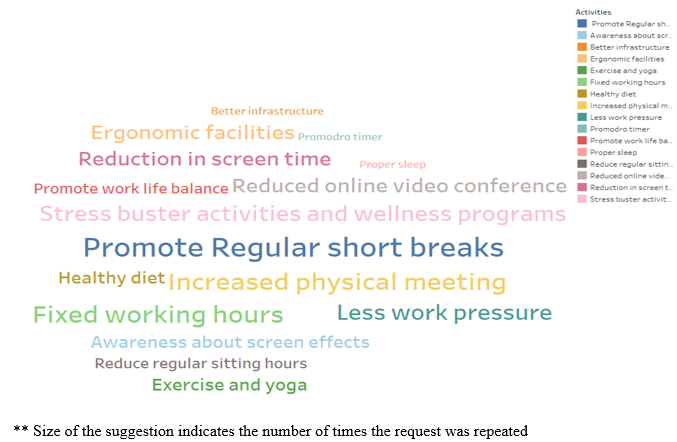
From the Size of the suggestions, it's clear that people wanted to encourage regular short breaks, more physical activity, activities that help relieve stress, etc.
Some suggestions are quoted below
Being an IT employee, there is no escape from the screen time, but less pressure time and freedom to exercise a healthy routine; cheerful colleagues shall help IT employees give better productivity and keep them healthy.
"Since COVID, we get minimal breaks while at work. Even the lunch break time has been reduced. Perhaps we can put some gaps in between work hours. "
"Industry standard guidelines can be followed so that the new way of working (created during COVID) can be normalized since taking time-offs, frequent breaks, etc. is still not appreciated."
Decision Tree and Its Discussion
From the decision tree, we can derive that
79% of the population have eye problems [(51+28 % ]
21% are sure that they don't suffer from any issues
But due to the sitting hours, 68% of people suffer musculoskeletal problems. To solve this problem, companies could implement a 5-minute exercise plan every two hours to provide rest for the eyes and musculoskeletal issues that develop gradually due to prolonged sitting hours.
We see that a significantly less proportion of people now have 6 hours of screen time. Screen time has excessively increased due to long work hours and the time spent in front of the screen due to personal reasons. We also see that people with only 6 hours of screen time do not suffer from eye problems.
Some people working for more than 6 hours have eye problems, but some have also responded that they may have eye problems.
Some are taking measures to protect their eyes from the harmful effects of sitting in front of the screen. But the proportion of these people is tiny.
From the decision tree, we can derive that even though people take measures to care for their eyes, they still suffer from eye problems. So, it can be concluded that people might not follow all the protocols correctly to care for their eyes.
Now we can derive from the decision tree that people with more work experience tend to suffer fewer eye problems than those with less work experience. There is a straightforward explanation for this. The Use of laptops, computers, televisions, and phones has grown immensely in the last decade. People who have had work experience of more than seven years are not used to using a handful of devices. But people who have experienced less than that have become accustomed to using many devices, thus increasing the exposure to the eyes. Hence, they suffer from more eye problems.
Discussion
We studied screen time effects on visual and musculoskeletal problems and its impact on work efficiency in professionals across India. It was found that screen time had moderately affected most respondents—79% of people suffering from visual problems and 68% from musculoskeletal issues. Visual problems were like eye irritation, headaches, dry eyes, etc., some of the joint and significant issues faced by people of different age groups, work experience and gender.
Employees are trying to take different measures based on the problems. But it is important to note that out of the total respondents who had a prevalence of visual problems, it was found that 38.53% of people took no measures to prevent the adverse effects of the screen on their eyes, and for those with musculoskeletal problems, 57.9 % took no steps. With the upcoming increase in screen time, especially after covid, it could be an excellent opportunity for 3rd party healthcare providing company to merge with the organizations and take necessary steps to help the employees deal with these problems.
Also, as some people believe that their efficiency at work can increase with the decrease in screen time, organizations can test this among their employees and provide fixed screen time. It can benefit both the employee as well as the organization.
Screen time among 73% of professionals has increased significantly, and working from home has reduced physical meetings, which has diminished exercise and physical activity among professionals.
As stated in the suggestions, organizations can promote regular screen breaks, have small physical exercise after a few hours, and have fixed working hours (as shown in the decision tree that those who have less screen time exposure are less likely to face these problems), reduce screen time and online video conferencing, and provide better infrastructure and ergonomic activities.
Employees can try exercising and yoga, have a high water intake, consume a healthy diet, and get proper sleep.
And both organizations and employees can try to use Promo do Timer, perform stress-buster activities and wellness programs, and create awareness about screen time effects.
Around 55% of respondents believed that their organization is trying to protect them from the adverse effects of screen time by promoting device-free meetings, using an ergonomic mouse, keyboard, and chairs, and implementing yoga and exercise programs.(IJmker et al., 2007)
But others stated that the organization made no extra efforts. This can be alarming for the organization and employees, as screen time is inevitable. But it is the organizations' and the employees' roles to ensure that screen time's long-term effects are taken care of. Otherwise, many physical and mental consequences will pave the way for the future. Taking responsibility for employees' health will directly benefit the organization. They can do this by taking all the small and big possible measures they can take along with the help of third-party involvement.
Limitations
The sample for the population included people with different geographical locations and work experience, but more insights could have been drawn if the sample population had been more. The study could be more detailed if the employees' feedback, employers' and HR's feedback, views and solutions on this issue could also be recorded.
Conclusion
The major problem with the increase in screen time is that the tendency to be physically active is reducing. WHO recommends 150 minutes of moderate workout per week. More than 2/3rd of the population suffers from eye and musculoskeletal problems. And half of the people are not taking any measures to deal with them. These problems lead to increased stress, undesirable eating habits, a decrease in life expectancy, and increased pressure, which makes them more irritated towards their work.
Employees, as well as employers, have started making efforts to deal with these problems. Still, the occupational health of those working in the computer field must be prioritized as a public health priority. Focusing on employee health will benefit the former and increase the company's productivity in the long run. Digitalization is the future, but small changes in day-to-day life and habits can bring proper control in the life of every individual, which will be very beneficial in the long run.

